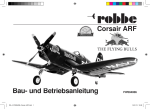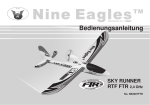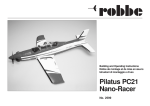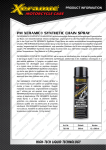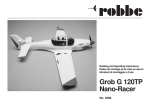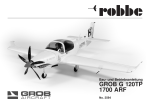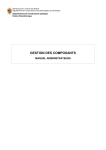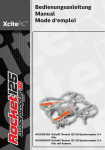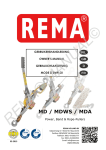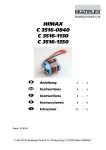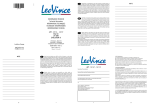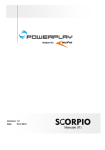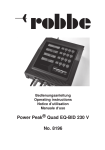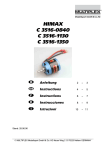Download Wichtige Hinweise für Modelle aus der Align T
Transcript
Wichtige Hinweise für Modelle aus der Align T-REX RTF Serie Sehr geehrter Kunde, vielen Dank, dass Sie sich für ein Produkt unseres Hauses entschieden haben und das uns damit entgegengebrachte Vertrauen. Die vorliegende Anleitung ist eine Zusammenfassung aller relevanten Sicherheitshinweise inklusive der wichtigsten Montagehinweise aller T-REX Helis. Sollte sich in dem Montagesatz Ihres T-REX keine typenspezifische Montageanleitung befinden, können Sie diese per E-Mail unter [email protected] anfordern. Bitte geben Sie unbedingt die Seriennummer und die Artikelnummer in Ihrer E-Mail an, da eine Bearbeitung sonst nicht möglich ist. Mit freundlichen Grüßen Ihr robbe Modellsport Team Vor der Inbetriebnahme von Align Modellen auch die Anleitungen der jeweiligen Fernsteuerung, des Ladegeräts und allen anderen Einzelkomponenten sowie alle Sicherheitshinweise beachten. Achtung, Verletzungsgefahr: Halten Sie bitte immer einen ausreichenden Sicherheitsabstand zu Ihrem Modellhelikopter (auch zu kleinen Koaxial- oder Singlerotor-Modellen). Überfliegen Sie niemals Zuschauer, andere Piloten oder sich selbst. Führen Sie Flugfiguren immer in vom Piloten oder Zuschauern abgewandter Richtung aus. Bitte beachten Sie, dass gerade kunstflugtaugliche Modellhelikopter enormen Belastungen im Flug ausgesetzt sind und das auch hochwertigste Fernsteuerungskomponenten eine Störung aufweisen können. Gerade der Betrieb dieser Modelle erfordert ein hohes Maß an Verantwortungsbewusstsein und größtmögliche Sicherheitsvorkehrungen für Pilot und Zuschauer. Konformitätserklärung Hiermit erklärt die robbe Modellsport GmbH & Co. KG, dass sich dieses Gerät in Übereinstimmung mit den grundlegenden Anforderungen und anderen relevanten Vorschriften der entsprechenden CE Richtlinien befindet. Die OriginalKonformitätserklärung finden Sie im Internet unter www.robbe.com, bei der jeweiligen Gerätebeschreibung durch Aufruf des Logo-Buttons „Konformitätserklärung“. Altgeräteensorgung Dieses Symbol bedeutet, dass elektrische und elektronische Geräte am Ende ihrer Nutzungsdauer vom Hausmüll getrennt, entsorgt werden müssen. Entsorgen Sie das Gerät bei Ihrer örtlichen, kommunalen Sammelstelle oder Recycling-Zentrum. Dies gilt für alle Länder der Europäischen Union sowie in anderen Europäischen Ländern mit separatem Sammelsystem. Lesen Sie vor dem Betrieb Ihres Modells unbedingt die Sicherheitshinweise genau durch. Halten Sie sich stets an die in den Anleitungen empfohlenen Vorgehensweisen und Einstellungen. Sicherheitshinweise • Ferngesteuerte Modelle sind kein Spielzeug im üblichen Sinne und dürfen von Jugendlichen unter 14 Jahren nur unter Aufsicht von Erwachsenen eingesetzt und betrieben werden. • Ihr Bau und Betrieb erfordert technisches Verständnis, handwerkliche Sorgfalt und sicherheitsbewusstes Verhalten. Fehler oder Nachlässigkeiten beim Bau, Fliegen oder Fahren können erhebliche Sach- oder Personenschäden zur Folge haben. • Da Hersteller und Verkäufer keinen Einfluss auf den ordnungsgemäßen Bau und Betrieb der Modelle haben, wird ausdrücklich auf diese Gefahren hingewiesen und jegliche Haftung ausgeschlossen. • Rotoren bei Hubschraubern und generell alle sich bewegenden Teile stellen eine ständige Verletzungsgefahr dar. Vermeiden Sie unbedingt eine Berührung solcher Teile. • Beachten Sie, dass Motoren, Regler und Auspuffanlagen im Betrieb hohe Temperaturen erreichen können. Vermeiden Sie unbedingt eine Berührung solcher Teile. • Bei Elektromotoren mit angeschlossenem Antriebsakku niemals im Gefährdungsbereich von rotierenden Teilenaufhalten. Achten Sie ebenfalls darauf, dass keine sonstigen Gegenstände mit sich drehenden Teilen in Berührung kommen! Beachten Sie die Hinweise der Akkuhersteller. Über- oder Falschladungen können zur Explosion der Akkus führen. Achten Sie auf richtige Polung. 1 Schützen Sie Ihre Geräte vor Staub, Schmutz und Feuchtigkeit. Setzen Sie die Geräte keiner übermäßigen Hitze, Kälte oder Vibrationen aus. Der Fernsteuerbetrieb darf nur im angegebenen Temperaturbereich durchgeführt werden. Benutzen Sie nur mitgelieferte oder empfohlene Ladegeräte und laden Sie Ihre Akkus nur bis zur angegebenen Ladezeit. Überprüfen Sie Ihre Geräte stets auf Beschädigungen und erneuern Sie defekte Teile mit Original-Ersatzteilen. Durch Absturz beschädigte oder nass gewordene Geräte, selbst wenn sie wieder trocken sind, nicht mehr verwenden! Entweder im robbe Service überprüfen lassen oder ersetzen. Durch Nässe oder Absturz können versteckte Fehler entstehen, welche nach kurzer Betriebszeit zu einem Funktionsausfall führen. Es dürfen nur die von uns empfohlenen Komponenten und Zubehörteile eingesetzt werden. Verwenden Sie immer original robbe - Futaba Steckverbindungen sowie Original robbe-Futaba Ersatzteile. An den Fernsteueranlagen dürfen keinerlei Veränderungen vorgenommen werden. Routineprüfungen vor dem Start • Bevor Sie den Empfänger einschalten, vergewissern Sie sich, dass der Gasknüppel auf Stopp / Leerlauf steht. • Immer zuerst den Sender, dann den Empfänger einschalten. • Immer zuerst den Empfänger, dann den Sender ausschalten. • Führen Sie vor dem Start einen Reichweitentest durch. • Ist der richtige Modellspeicher ausgewählt? • Führen Sie einen Funktionstest durch. Prüfen Sie die Laufrichtung und die Ausschläge der Ruder am Modell. • Sind Mischfunktionen und Schalter richtig eingestellt? • Ist der Ladezustand der Akkus ausreichend? • Im Zweifel Modell niemals starten! Modellbetrieb • Überfliegen Sie niemals Zuschauer oder andere Piloten und halten Sie genügend Sicherheitsabstand zu Ihrem Modell. • Gefährden Sie niemals Menschen oder Tiere. • Fliegen Sie nie in der Nähe von Hochspannungsleitungen oder Wohngebieten. • Betreiben Sie Ihr Modell nicht auf öffentlichen Straßen, Autobahnen, Wegen und Plätzen etc., sondern nur an zugelassenen Orten. • Bei Gewitter dürfen Sie Ihre Anlage nicht betreiben. Im Betrieb nicht mit der Senderantenne auf das Modell „zielen“. In dieser Richtung hat der Sender die geringste Abstrahlung. Am Besten ist die seitliche Stellung der Antenne zum Modell. Versicherung Bodengebundene Modelle sind üblicherweise in einer Privathaftpflichtversicherung mitversichert. Für Flugmodelle ist eine Zusatzversicherung oder Erweiterung erforderlich.Überprüfen Sie Ihre Versicherungspolice und schließen sie ggf. eine Versicherung ab. Haftungsausschluss: Sowohl die Einhaltung der Montage- und Betriebsanleitung als auch die Bedingungen und Methoden bei Installation, Betrieb, Verwendung und Wartung der Modellbaukomponenten können von robbe-Modellsport nicht überwacht werden. Daher übernehmen wir keinerlei Haftung für Verluste, Schäden oder Kosten, die sich aus fehlerhafter Verwendung und Betrieb ergeben oder in irgendeiner Weise damit zusammenhängen. Soweit gesetzlich zulässig ist die Verpflichtung zur Schadenersatzleistung, gleich aus welchen Rechtsgründen, auf den Rechnungswert der an dem schadensstiftenden Ereignis unmittelbar beteiligten robbe-Produkten begrenzt. Dies gilt nicht, soweit nach zwingenden gesetzlichen Vorschriften wegen Vorsatzes oder grober Fahrlässigkeit unbeschränkt gehaftet werden muss. 2 Hinweise zur Betriebsanleitung: •Als Basis für die Kurztexte in den deutschen Anleitungen dienen die englischen Anleitungen der jeweiligen Modelle, in welchen Sie auch die erforderlichen Abbildungen finden. •Die Texte halten sich an die Reihenfolge dieser Anleitungen, stellen jedoch keine wörtliche Übersetzung dar. •Seitenangaben beziehen sich auf die englischen Anleitungen. •Alle in den Montageanleitungen angegebenen Gestängelängen und Servohebellängen beziehen sich auf die Verwendung von Align-Servos. •Bei Einsatz von Servotypen anderer Fabrikate können diese Maße leicht abweichen. •Zu jeder Baustufe erklären die Montagezeichnungen den Zusammenbau. Alle benötigten Kleinteile sind zur besseren Identifikation mit ihren Maßen separat abgebildet. Hinweise zu Ersatzteilen •Es ist besonders wichtig, daß Sie nur Original-Ersatzteile verwenden. •Ersatzteile sind nur in den Sets lieferbar, die in der Ersatzteilliste angegeben sind. •Bitte bewahren Sie die Betriebsanleitung für spätere Montage- oder Reparaturarbeiten unbedingt auf. •Um eine zügige und unkomplizierte Ersatzteilversorgung zu gewährleisten, sollten Sie bei einer Bestellung immer die OriginalBestell-Nummer verwenden. •Sollte ein dringend benötigtes Ersatzteil einmal nicht bei Ihrem Händler vorrätig sein, so haben Sie die Möglichkeit alle Ersatzteile schnell und unkompliziert direkt bei robbe zu beziehen. Hinweise hierzu entnehmen Sie bitte der aktuellen Preisliste. Die Adresse lautet: robbe Modellsport GmbH & Co. KG Ersatzteil-Schnell-Dienst (ESD) Metzloser Str. 38 36355 Grebenhain Telefon: 06644/87333 Telefax: 06644/ 87339 Für eventuelle Reklamationen bzw. Gewährleistungsfälle ist die Vorlage des Kaufbelegs sowie die Angabe der Seriennummer zwingend notwendig. Allgemeine Hinweise Auf Leichtgängigkeit und spielfreie Montage aller beweglichen Teile achten. Schrauben gefühlvoll festziehen ohne sie zu überdrehen. Begriffe für Schrauben und Kleinteile Self tapping screw: Screw: Socket screw: Cross screw: Set screw: Collar screw: Socket collar screw: Socket button head screw: Socket button head self tapping screw: Set screw Nut Washer Specialty washer: Spacer Collar Bearing Thrust bearing Pin Linkage ball Ball link Linkage rod: Servo linkage rod: One way bearing: Damper rubber: Spacer Selbstschneidende Schraube Gewindeschraube Innensechskantschraube Kreuzschlitz-Senkschraube Stiftschraube Schraube mit Bund Innensechskantschraube mit Bund Innensechskantschraube Innensechskant-Blechschraube Innensechskant-Madenschraube Mutter Unterlegscheibe Spezial-Unterlegscheibe Passscheibe Distanzhülse Kugellager Axiallager Stift Kugel Kugelkopf Gestänge Servogestänge Freilauf Dämpfungsgummi Distanzscheibe 3 Beim Aufdrücken der Kugelgelenke beachten, dass die Markierung “A” außen liegt. R48 (grün) / T22 (lila) / T43 (blau) haftet intensiv. Nur wenig Sicherungsmittel aufbringen. Zur Demontage, Metallteile ca. 15 sec. erhitzen. Achtung: Kunststoffteile nicht erhitzen. Alle Gewinde und Gewindebohrungen vor dem Zusammenbau entfetten (Nitro), da Gewindesicherungsmittel oder Klebstoff sonst nicht haftet. Bei allen Baugruppen nochmals den festen Sitz aller Schrauben bzw. deren Verklebung (Sicherung) prüfen. Funktionsprobe Immer zuerst den Sender, dann den Empfänger einschalten. Führen Sie einen Funktionstest durch. Prüfen Sie die Laufrichtung und Ausschläge am Modell. Rollfunktion: Bei Betätigen des Roll-Knüppels nach links muß sich die Taumelscheibe links senken. Nickfunktion: Bei Betätigen des Nick-Knüppels nach vorn muß sich die Taumelscheibe nach vorn senken. Gas/Pitchfunktion: Wird Vollgas gegeben, muß sich die Taumelscheibe gleichmäßig heben. Heckrotor: Servolaufrichtung prüfen. Kreiselwirkrichtungskontrolle Heckausleger zügig um die Hochachse nach rechts schwenken (Nase bewegt sich nach links). Das obere eingeklappte Heckrotorblatt muß sich mit seiner Spitze vom Heckrohr weg bewegen. (“Re“) Gegebenenfalls Kreiselwirkungsrichtung umschalten (siehe Anleitung FLB-System oder Heckkreisel). Hauptrotorblätter, Blattspurlauf Die Rotorblätter durch die Aufnahmebohrungen mit einer Schraube und einer Mutter gegeneinander verschrauben. Die so montierten Rotorblätter mittig unterstützen. Das leichtere Blatt, welches nun nach oben zeigt, sollte mit Hilfe von farbiger Folie so austariert werden, daß sich die Rotorblätter waagerecht auspendeln. Einstellen Blattspurlauf: Beim ersten Betrieb des Modells muß eventuell der Blattspurlauf noch eingestellt werden. Dazu vorsichtig Gas geben und bei laufendem System den Blattspurlauf kontrollieren. Sollte sich bei Schwebeflugdrehzahl eine Differenz im Blattspurlauf ergeben, so muß entweder das tieferlaufende Blatt im Anstellwinkel erhöht werden oder aber gegensinnig das höherlaufende Blatt im Anstellwinkel verkleinert werden. Wichtig Nach der ersten Inbetriebnahme sind alle Schraubverbindungen (besonders an Antriebsteilen und Rotorsystem) auf festen Sitz zu überprüfen. Alle 2 bis 3 Betriebsstunden sollten alle folgenden Stellen des Hubschraubers erneut gefettet bzw. geölt werden: Hauptrotorwelle im Bereich der Taumelscheibe. Heckrotorwelle im Bereich des Heckrotorschiebestückes. Hauptgetriebe Noch ein Tip zum Schluß Auf die Hilfe eines erfahrenen und guten Heli-Piloten sollten Sie nie verzichten. Viele Dinge erklären sich fast von selbst, wenn man auf die Erfahrung eines kompetenten Helifliegers zurückgreifen kann. robbe Modellsport GmbH & Co. KG 4 robbe-Form 40-4948 Stand: 10/2013 Important Notes for models in the Align T-REX series Dear customer, Many thanks for your decision to purchase one of our products, and the trust you have shown in us. These instructions summarise all the relevant safety notes including the essential assembly notes relating to all T-REX helicopters. If your T-REX kit does not include type-specific assembly instructions, you can request a copy by e-mail using the following address: [email protected]. Please be sure to state the serial number and the article number in your e-mail message, since we cannot process your request without this information. Yours sincerely, Your robbe Modellsport Team Before assembling and operating an Align model be sure to read the instructions supplied with the radio control system, the battery charger and all the other electronic components as well as all the Safety Notes. Caution - injury hazard: Please keep your model helicopter a safe distance away from you and others, including other small co-axial and single-rotor models. Never fly over spectators, other pilots or yourself. Always fly manoeuvres facing away from other pilots and spectators. Please note that model helicopters generally, and aerobatic types in particular, are subject to enormous flight loads, and that interference cannot be ruled out even when you are using the best possible radio control system components. Operating this type of model calls for a responsible attitude and all possible safety precautions to protect pilots and spectators. Conformity declaration robbe Modellsport GmbH & Co. KG hereby declares that this device conforms to the fundamental requirements and other relevant regulations of the corresponding EC Directive. You can read the original Conformity Declaration on the Internet at www.robbe.com: click on the "Conformity Declaration" logo button which you will find next to the corresponding device description. Disposal of unwanted equipment This symbol means that it is essential to dispose of electrical and electronic equipment separately from the domestic refuse when it reaches the end of its useful life. Take your unwanted equipment to your local communal collection point or recycling centre. This applies to all countries of the European Union, and to other European countries with separate waste collection systems. It is essential to read the safety notes before operating your model. Always keep to the procedures and settings recommended in the instructions. Safety Notes • Radio-controlled models are not toys in the usual sense of the term. Young persons under fourteen years should only be allowed to operate them under the supervision of an adult. • Building and operating these models requires technical expertise, manual skills, a careful attitude and safety-conscious behaviour. Errors, negligence and omissions in building or flying these models can result in serious personal injury and damage to property. • Since the manufacturer and vendor are not in a position to check that your models are built and operated correctly, all we can do is bring these hazards expressly to your attention. We deny all further liability. • Helicopter rotors, and all moving parts generally, constitute a constant injury hazard. It is essential to avoid touching such parts. • Please bear in mind that motors and speed controllers may become hot when operating. It is essential to avoid touching such parts. • Do not stand close to the hazard area around rotating parts when an electric motor is connected to the flight battery. You must also take care to keep all other objects away from moving or rotating parts. Observe the instructions provided by the battery manufacturer. Overcharged or incorrectly charged batteries may explode. Take care to maintain correct polarity. 5 Ensure the equipment is protected from dust, dirt and moisture contamination. Do not subject components to excessive heat, cold or vibration. The radio control system may only be operated when the ambient temperature is within the stated range. Use only the recommended battery charger or the charger supplied, and do not charge your batteries for longer than the stated period. Check your equipment for damage at regular intervals, and replace defective components with genuine spare parts. Do not re-use any devices which have been damaged in a crash or by water, even when they have dried out again. Send the equipment to the robbe Service Department for checking, or replace the parts in question. Crash or water damage can result in concealed defects which may lead to failure in subsequent use. Use only those components and accessories which we specifically recommend. Always use original robbe - Futaba connectors and spare parts. Never make modifications of any kind to the radio control equipment. Routine pre-flight checks • Before switching on the receiver, ensure that the throttle control on the transmitter is at the "motor stop / idle" position. • Always switch on the transmitter first, and then the receiver. • Always switch off the receiver first, and only then the transmitter. • Carry out a range check before each flying session. • Have you selected the correct model memory? • Check all the working systems. Ensure that the model's control surfaces deflect in the correct sense (direction) and to the stated extent. • Are all the mixer functions and switches set correctly? • Are the batteries sufficiently charged? • If you are not sure of any point - don’t fly the model! Operating the model • Never fly over or towards spectators or other pilots, and maintain a safe distance from them at all times. • Never endanger people or animals. • Never fly close to high-tension overhead cables or residential areas. • Do not operate your model from public roads, motorways, paths and squares etc. Fly from authorised sites only. • Never operate your equipment in stormy weather. Never “point” the transmitter aerial straight at the model when operating it. The transmitter signal is at its weakest in this direction. It is always best to stand with the long side of the aerial angled towards the model. Insurance Ground-based models are usually covered by standard personal third-party insurance policies. If you wish to fly model aircraft you will need to extend the cover of your existing policy, or take out specific insurance. Check your insurance policy, and take out new cover if necessary. Liability Exclusion robbe Modellsport is unable to ensure that you observe the assembly and operating instructions, or the conditions and methods used for installing, operating and maintaining the model components. For this reason we accept no liability for loss, damage or costs which are due to the erroneous use and operation of our products, or are connected with such operation in any way. Regardless of the legal argument employed, our obligation to pay compensation is limited to the invoice value of those robbe products directly involved in the event in which the damage occurred, unless otherwise prescribed by law. This does not apply if the company is deemed to have unlimited liability according to statutory regulation due to deliberate or gross negligence. 6 Notes on the operating instructions: •The basis of the brief texts in the German instructions is the English instructions for the appropriate model, in which you will also find the relevant illustrations. •The texts follow the sequence of these instructions, but do not constitute a literal translation. •The stated page numbers refer to the English instructions. •All the pushrod and servo output arm lengths stated in the instructions only apply if Align servos are used. •If you prefer to use other makes of servo, you may have to alter the stated dimensions slightly. •The assembly drawings are very useful in explaining each stage of assembly. All the small items required are illustrated separately, together with their dimensions, to help you identify them. Notes on replacement parts •It is particularly important to use genuine spare parts exclusively. •Spare parts are only available in the sets stated in the Replacement Parts List. •Please keep this assembly manual in a safe place in case you need to refer to it later for re-assembly work or repairs. •To ensure that spare parts are delivered swiftly and efficiently, it is essential to use the original Order Number when placing your order. •If you urgently need a spare part which your model shop does not have in stock, you can obtain all replacement parts quickly and simply direct from robbe. Please refer to the current Price List for details of the procedure. The address is as follows: robbe Modellsport GmbH & Co. KG Express Spares Service (ESD) Metzloser Str. 38 D-36355 Grebenhain Telephone: 06644-87333 Fax: 06644-87339 If you have a complaint or wish to make a claim under guarantee, please note that it is essential to provide proof of purchase (receipt), and state the serial number. General notes Check that all moving parts move smoothly but without lost motion (slop). Tighten screws cautiously; overtightening may strip the threads. Terms relating to screws and small hardware items Self tapping screw: Selbstschneidende Schraube Screw: Gewindeschraube Socket screw: Innensechskantschraube Cross screw: Kreuzschlitz-Senkschraube Set screw: Stiftschraube Collar screw: Schraube mit Bund Socket collar screw: Innensechskantschraube mit Bund Socket button head screw: Innensechskantschraube Socket button head self tapping screw: Innensechskant-Blechschraube Set screw Innensechskant-Madenschraube Nut Mutter Washer Unterlegscheibe Specialty washer: Spezial-Unterlegscheibe Spacer Passscheibe Collar Distanzhülse Bearing Kugellager Thrust bearing Axiallager Pin Stift Linkage ball Kugel Ball link Kugelkopf Linkage rod: Gestänge Servo linkage rod: Servogestänge One way bearing: Freilauf Damper rubber: Dämpfungsgummi Spacer Distanzscheibe 7 When pressing ball-links onto the linkage balls note that the embossed "A" should be on the outside. R48 (green) / T22 (lilac) / T43 (blue) bonds strongly. Apply the thread-lock fluid sparingly. Heat metal parts for about fifteen seconds to dismantle the joint. Caution: do not heat plastic parts. De-grease all threaded components and holes using cellulose thinners before assembling the parts, otherwise thread-lock fluid and glue will not adhere. Check that all screws in these sub-assemblies are tight, and that thread-lock fluid has been used. Checking the working systems Always switch on the transmitter first and then the receiver. Check all the working systems. Ensure that the model's control surfaces deflect in the correct direction, and that their travels are as stated. Roll function: when you move the roll stick to the left, the left-hand side of the swashplate must fall. Pitch-axis function: when you move the pitch-axis stick forward, the front of the swashplate must fall. Throttle / collective pitch function: when you apply full-throttle, the swashplate should rise evenly. Tail rotor: check the direction of servo rotation. Checking the direction of gyro effect Swing the tail boom briskly to the right, around the vertical axis (nose to the left). With the tail rotor blades folded in, the tip of the upper blade should now move away from the tail boom ("Ri"). Reverse the direction of gyro effect if necessary (see instructions for the FLB system or the tail gyro). Main rotor blades, blade tracking Temporarily fix the rotor blades together through the blade grip holes using a screw and nut, and support the joined blades in the centre. The lighter blade will now rise; apply coloured film to the tip until the blades balance level. Checking blade tracking: you may need to adjust blade tracking the first time you fly the model. This is the procedure: cautiously open the throttle, and check whether the rotating blade tips are at the same height. If you detect a difference when the rotor is at hover speed, you need either to increase the pitch of the lower blade, or reduce the pitch of the higher blade. Important After the first flight it is essential to check that all screwed joints - especially those in the power and rotor systems - are still firmly seated. All the following areas of the helicopter should be re-greased or oiled after every two or three hours of operation: Main rotor shaft in the swashplate area. Tail rotor shaft in the area of the tail rotor slider. Main gearbox And one final tip Never try to manage without the help of a good, experienced helicopter pilot. Many things are obvious when explained by a competent chopper flyer. robbe Modellsport GmbH & Co. KG 8 robbe-Form 40-4948 Date of issue: 10/2013 Remarques importantes concernant les modèles Align de la série T-REX RTF Cher client, Merci d'avoir choisi un produit de notre maison et de la confiance que vous nous faites. Cette notice est un résumé des toutes les consignes de sécurité les plus importantes avec les consignes de montage essentielles concernant tous les hélicoptères T-REX. Si l'emballage de votre kit T-REX ne comprend pas de notice de montage appropriée, vous pouvez en réclamer une par courriel à [email protected]. Indiquez impérativement le numéro de série et le numéro d'article dans votre courriel, sinon nous ne sommes pas en mesure de vous donner satisfaction. Meilleures salutations. Votre équipe robbe Modellsport Avant le montage et la première mise en service de votre modèle Align, lisez attentivement également les notices des composants électroniques, de tous les autres composants individuels et observez toutes les consignes de sécurité. Attention, risque de blessures : Conservez toujours une distance de sécurité par rapport à votre modèle d'hélicoptère (également s'il s'agit d'un appareil coaxial ou d'un monomoteur). Ne survolez jamais des spectateurs ou d’autres pilotes ou vous-même. Exécutez toujours les figures de voltige dans le sens opposé au pilote ou aux spectateurs. N'oubliez pas que particulièrement les modèles d'hélicoptère susceptibles de faire de la voltige sont soumis à d'énormes charges en cours de vol et que même les composants de haute qualité de l'ensemble de radiocommande sont susceptibles de subir des dérangements. La mise en œuvre de ces modèles justement exige un haut degré de responsabilité et les mesures de sécurité les plus contraignantes de la part des pilotes et des spectateurs. Déclaration de conformité Par la présente, la société robbe Modellsport GmbH & Co. KG déclare que cet appareil est conforme avec les exigences fondamentales et les autres prescriptions de la directive CE correspondante. Vous trouverez l'original de la déclaration de conformité sur Internet à l'adresse wwww.robbe.com, à la description de l'appareil en question en cliquant sur le bouton portant le logo « Déclaration de conformité ». Mise au rebut des appareils usagés Ce symbole signifie que les appareils électriques et électroniques irréparables ou en fin de cycle d’exploitation doivent être mis au rebut non pas avec les ordures ménagères mais dans les déchetteries spécialisées. Portez-les dans les collecteurs communaux appropriés ou un centre de recyclage spécialisé. Cette remarque s’applique aux pays de la Communauté européenne et aux autres pays européens pourvus d’un système de collecte spécifique. Avant toute mise en œuvre, veuillez lire absolument et avec la plus grande attention les consignes de sécurité. Respectez impérativement les procédures et réglages recommandés dans les notices. Consignes de sécurité • Les modèles réduits radiocommandés ne sont pas des jouets dans le sens habituel du terme et ne doivent pas être utilisés ni commandés par des jeunes de moins de 14 ans sans la présence d’un adulte. • La construction et la mise en œuvre exigent un certain nombre de connaissances techniques, un soin artisanal et un comportement conscient du point de vue de la sécurité. Des erreurs ou un manque d'application lors de la construction, du vol ou de la conduite sont susceptibles de provoquer des dommages matériels ou des blessures considérables. • Ni le fabricant ni le vendeur n’ont d’influence sur la construction et l’exploitation correctes des modèles réduits et déclinent toute responsabilité dans ce sens. • Les rotors sur les hélicoptères et en règle générale tous les éléments en rotation représentent un danger de blessure permanent. Évitez absolument d’entrer en contact avec de tels éléments. • Tenez compte du fait que les moteurs, les variateurs et les pots d'échappement peuvent atteindre une température élevée en cours de fonctionnement. Évitez absolument d’entrer en contact avec de tels éléments. • Ne jamais stationner dans le secteur dangereux d'éléments en rotation lorsqu’un accu d’entraînement est raccordé à un moteur électrique. Veillez également à ne pas entrer en contact avec des éléments en rotation à l’aide d’objets quelconques ! Observez impérativement les consignes fournies par le fabricant des accus. Les surcharges ou les charges inappropriées sont susceptibles de provoquer l'explosion des accus. Attention à la polarité. 9 Protégez vos appareils de la poussière, des saletés et de l'humidité. N'exposez pas la radiocommande à des températures excessives, au-dessous ou en dessous de zéro ou à des vibrations. Le fonctionnement télécommandé ne doit avoir lieu qu'aux températures indiquées. N'utilisez que les appareils livrés ou que nous recommandons et ne chargez vos accus que dans les délais mentionnés. Contrôlez l'absence de dommages sur vos appareils et remplacez les pièces défectueuses par des pièces de rechange d'origine. Ne réutilisez pas les appareils endommagés par une chute ou les appareils mouillés, même lorsqu'ils ont séché ! Les faire contrôler par le service après-vente robbe ou les remplacer. L'humidité ou une chute peut entraîner des dysfonctionnements cachés susceptibles d'induire une panne de fonctionnement après une brève utilisation. N’utilisez que les composants et les accessoires que nous recommandons. Utilisez systématiquement les connecteurs robbe-Futaba d'origine ainsi que les pièces de rechange robbe-Futuba d'origine. Ne procédez à aucune modification sur les télécommandes. Contrôles de routine avant de démarrer • Avant de mettre le récepteur en marche, assurez-vous que le manche des gaz se trouve sur arrêt/ralenti. • Mettez toujours d'abord l'émetteur en marche puis le récepteur. • Coupez toujours d'abord le récepteur avant de couper l’émetteur. • Avant le démarrage, effectuez un essai de portée. • Avez-vous sélectionné la mémoire de modèle appropriée ? • Procédez à un essai des fonctions. Vérifiez les sens de débattement et l'importance des débattements des gouvernes sur le modèle. • Les fonctions de mixage et les commutateurs sont-ils correctement réglés ? • La charge des accus est-elle suffisante ? • En présence d’un doute, ne démarrez jamais le modèle ! Mise en œuvre du modèle • Ne survolez jamais des spectateurs ou d'autres pilotes et respectez une certaine distance de sécurité par rapport à votre modèle. • Ne mettez jamais des personnes ou des animaux en danger. • Ne volez jamais au voisinage de lignes à haute tension ou de zones habitées. • N'utilisez jamais votre modèle réduit sur des voies publiques, des autoroutes, des chemins et des places, etc., mais uniquement à des emplacements autorisés. • N'utilisez pas votre télécommande par temps orageux. Pendant la séance de pilotage, ne jamais „viser“ l’appareil avec l’antenne de l’émetteur. C’est dans cette direction que le rayonnement de l’émetteur est le plus faible. L'idéal est une position latérale de l'antenne par rapport au modèle. Assurance Les modèles évoluant au sol, sont généralement couverts par l'assurance personnelle en responsabilité civile. Pour les modèles volants, il faut généralement disposer d’une assurance complémentaire ou d’une extension de l’assurance. Vérifiez les risques couverts par votre assurance er, si nécessaires, prenez une assurance. Exclusion de la responsabilité : La société robbe-Modellsport n'est pas en mesure de contrôler le respect des instructions fournies par la notice de montage et d'utilisation ni les conditions ou la méthode d'installation, de mise en œuvre, d'utilisation et de maintenance des éléments de construction du modèle réduit. Nous ne pouvons donc être tenus pour responsables d'aucune perte, d'aucun dommage ni coût coséquents à une utilisation ou une mise en œuvre inadéquates ou de quelque conséquence que ce soit. Dans les limites du Droit et quels qu'en soient les motifs les produits robbe directement à l'origine de dommages ne peuvent être mis en cause ni donner droit au versement de dommages et intérêts. Ceci ne vaut pas dans le cas de directives contraignantes lorsque les intentions sont malveillantes ou en présence de négligences grossières. 10 Consignes concernant la notice de mise en œuvre : •La référence des textes courts dans les notices en langue allemande est la notice en langue anglaise de chacun des modèles, dans laquelle vous trouverez également les illustrations appropriées. •Les textes suivent en règle générale le déroulement de ces notices sans toutefois en constituer une traduction littérale. •Les indications de pagination se réfèrent aux notices en langue anglaise. •Toutes les longueurs de tringles et les longueurs des palonniers des servos fournies dans la notice se réfèrent aux servos Align recommandés. •La mise en œuvre de servos d'autres fabricants est susceptible de faire varier légèrement ces cotes. •Chaque stade de montage est accompagné d'illustrations d'assemblage spécifiques. Les petits éléments indispensables sont représentés séparément avec leurs cotes afin de faciliter leur identification. Indications concernant les pièces de rechange •Il est impératif de n'utiliser que des pièces de rechange originales. •Les pièces de rechange ne sont livrables que sous forme de kits tels qu’ils sont présentés dans la liste des pièces de rechange. •Il est absolument nécessaire de conserver la présente notice pour les travaux de montage ou de réparation ultérieurs. •Pour garantir la livraison rapide et sans complication des pièces de rechange, fournissez impérativement pour toute commande le numéro de référence original des pièces commandées. •Pour garantir la livraison rapide et sans complication des pièces de rechange, fournissez impérativement pour toute commande le numéro de référence original des pièces commandées. Le barème actuel fournit les informations nécessaires à ce propos. L'adresse est la suivante : robbe Modellsport GmbH & Co. KG Service de livraison rapide des pièces de rechange (ESD) Metzloser Str. 38 D-36352 Grebenhain Téléphone : 06644/87333 Télécopie : 0049 6644/ 87339 Toute réclamation ou tous les cas relevant de la garantie doivent faire l'objet d'une demande accompagnée impérativement de la facture de l'achat et de la mention du numéro de série. Indications générales Veiller à ce que toutes les pièces mobiles disposent d'une certaine souplesse sans jeu apparent. Serrer les vis avec sensibilité afin de ne pas en abîmer le filet. Désignation des vis et des petits éléments Self tapping screw: vis autotaraudeuse Screw: tige filetée Socket screw: vis six pans creux Cross screw: vis à tête fraisée croisée Set screw: goujon fileté Collar screw: vis à épaulement Socket collar screw: vis six pans creux avec collet Socket button head screw: vis six pans creux Hex socket self tapping screw: vis autotaraudeuse six pans creux Set screw vis sans tête six pans creux Gorge écrou Washer rondelle Specialty washer: rondelle spéciale Spacer Rondelle d’ajustage Collar douille d'écartement Bearing Roulements à billes Thrust bearing palier de butée Broche goupille Linkage ball bille Ball link pivot sphérique Linkage rod: tringle Servo linkage rod: timonerie de servo One way bearing: roue libre Damper rubber: caoutchouc d'amortissement Spacer: rondelle entretoise 11 Avant d'appliquer les pivots sphériques, veiller à ce que le repère “A ” se trouve à l'extérieur. R48 (vert) / T22 (violet) / T43 (bleu) adhère de manière intensive. N’appliquez que très peu de produit de freinage de filets. Pour le démontage, chauffer les éléments en métal approximativement pendant 15 s. Attention : veillez à ne pas chauffer les éléments en plastique. Attention : veillez à ne pas chauffer les éléments en plastique. Dégraisser tous les filets et les taraudage avant assemblage (nitro), sinon le frein de vis ou la colle n'adhère pas. Sur ces sous-groupes vérifiez tous les assemblages par vis et la présence de produit de freinage. Essai des fonctions Mettre toujours d'abord l'émetteur en marche puis le récepteur. Procéder à un essai des fonctions. Vérifier les sens de débattement et l'importance des débattements sur le modèle. Fonction roulis : lorsqu’on déplace le manche de roulis vers la gauche, il faut que le plateau cyclique s’incline vers la gauche. Fonction tangage : lorsqu’on actionne le manche des gaz vers l’avant, il faut que le plateau cyclique s’incline vers l’avant. Fonction gaz/pas : lorsqu’on donne plein gaz, il faut que le plateau cyclique s’élève de manière homogène. Rotor arrière : contrôler le sens de rotation du servo. Contrôle du sens d'intervention du gyroscope Déplacer rapidement la flèche de rotor arrière vers la droite (le nez de l'hélicoptère se déplace vers la gauche). La pale du haut du rotor arrière doit s'éloigner avec sa pointe de la flèche de rotor arrière. (“droite“) Si nécessaire, commutez le sens de l'efficacité du gyroscope (Cf. notice du système sans barre stabilisatrice ou du gyroscope du rotor arrière). Pales du rotor principal, tracking Visser les pales du rotor dans les alésages de logement avec une vis et un écrou de manière symétrique Caler les pales de rotor montées de la sorte au centre. Caler les pales de rotor montées de la sorte au centre. Appliquer un tarage constitué de ruban adhésif de couleur sur la pale la plus légère et donc plus haute que l'autre de manière que les deux pales soient parfaitement en équilibre. Mise au point du tracking : avant la première mise en service du modèle il faut encore éventuellement régler le tracking (plan de rotation des pales). Pour ce faire, donnez lentement des gaz et, lorsque le système est en marche, contrôlez l'horizontalité mutuelle des pales. S'il s'avérait, au régime du vol stationnaire, qu'il existe une différence au niveau du plan de rotation des pales, il faut soit augmenter l'angle d'incidence de la pale se trouvant plus bas, ou, à l'opposé, réduire l'angle d'attaque de la pale la plus haute. Important Après la première séance de vol, contrôler le serrage de toutes les vis (particulièrement sur les éléments de l'entraînement et sur le système du rotor). après toutes les 2 ou 3 heures de vol, lubrifier tous les emplacements suivants de l'hélicoptère : l'arbre du rotor principal dans le secteur du plateau cyclique, l'arbre du rotor arrière dans le secteur de l'élément coulissant du rotor arrière, Mécanisme principal Encore un conseil pour finir N'hésitez pas à prendre les conseils d'un bon pilote expérimenté de modèles réduits d'hélicoptère. Bon nombre de points trouvent une explication lorsqu'on a la possibilité de consulter un pilote d'hélicoptère expérimenté. robbe Modellsport GmbH & Co. KG 12 robbe-Form 40-4948 Édition : 10/2013 Gentili clienti, Indicazioni importanti per Modelli della serie Align T-REX RTF grazie per aver scelto un prodotto della nostra Azienda e per la vostra fiducia. La presenta guida è un riassunto di tutte le indicazioni di sicurezza rilevanti, nonché le indicazioni di montaggio di tutti gli elicotteri T-REX. Se nel set di montaggio del vostro T-REX non dovesse essere presente nessuna guida di montaggio specifica, è possibile richiederla a [email protected]. Fornire il Numero di serie e il Numero di articolo nella vostra E-Mail, altrimenti non sarà possibile un'elaborazione. Cordiali Saluti Il vostro Team robbe Modellsport Prima del montaggio e della messa in funzione del modello, leggere le istruzioni del radiocomando, del caricabatterie e di tutti gli altri singoli componenti, oltre che le norme di sicurezza. Attenzione, pericolo di lesioni! Mantenere una sufficiente distanza di sicurezza dal elicottero (mantenerla anche per i piccoli modelli coassiali e quelli con rotore singolo). Non sorvolate mai gli spettatori, altri piloti o voi stessi. Eseguite le acrobazie sempre in direzione opposta degli spettatori e/o piloti. Nota bene che soprattutto gli elicotteri con grandi potenzialità acrobatici, vengono esposti a enormi carichi e che anche le componenti dei radiocomandi di altissima qualità possono riscontrare dei disturbi. Soprattutto il funzionamento di questi modelli richiede un alto senso di responsabilità e le massime precauzioni di sicurezza per i piloti e per gli spettatori. Dichiarazione di conformità Con la presente robbe Modellsport GmbH & Co.KG dichiara che il presente prodotto è conforme alle direttive e norme europee. La versione originale della dichiarazione di conformità è reperibile su Internet al sito www.robbe.com alla descrizione specifica dell'apparecchio premendo sul tasto "Dichiarazione di conformità". Smaltimento apparecchiature usate Questo simbolo indica che al termine del loro utilizzo gli apparecchi elettronici devono essere smaltiti separatamente. Smaltire l'apparecchio presso gli appositi punti di raccolta, come i punti autorizzati dal comune. Questo vale per tutti i Paesi dell'Unione Europea e per tutti gli altri Paesi europei che attuano la raccolta differenziata dei rifiuti. Prima di montare il modello, leggere attentamente tutte le istruzioni e le norme per la sicurezza. Attenersi sempre alle procedure e alle regolazioni consigliate nelle istruzioni. Norme di sicurezza • I modelli radiocomandati non sono giocattoli nel senso convenzionale e possono essere impiegati e utilizzati da minori di 14 anni solamente sotto il controllo di un adulto. • Il loro montaggio e funzionamento richiedono capacità tecniche, manualità e un comportamento coscienzoso. Errori o trascuratezze durante il montaggio o l'uso potrebbero provocare lesioni o danni materiali. • Dal momento che né il produttore né il rivenditore possono avere alcun controllo sul corretto utilizzo del prodotto, il produttore richiama esplicitamente l'utente su tali rischi, declinando in tal modo qualsiasi responsabilità. • Rotori di elicotteri e, in generale, tutti i pezzi messi in rotazione da un motore, presentano sempre rischi di lesioni per ilpilotaeperchiglistaintorno. Non toccare mai tali componenti. • Attenzione: il motore e il regolatore possono raggiungere temperature elevate durante il funzionamento. Non toccare mai tali componenti. • Nei motori elettrici con accumulatore di azionamento collegato non sostare mai in prossimità di componenti rotanti. Prestare anche attenzione affinché nessun altro oggetto entri in contatto o si avvicini alle parti in rotazione! Rispettare attentamente le disposizioni fornite dal produttore degli accumulatori. La carica eccessiva o errata degli accumulatori ne può provocare l'esplosione. Prestare la massima attenzione alla giusta polarità. 13 Proteggere gli apparecchi da polvere, sporco e umidità. Evitare che gli apparecchi vengano a contatto con fonti di calore o freddo eccessivo oppure con vibrazioni. L'apparecchiatura trasmittente-ricevente può essere usata soltanto nell'intervallo di temperatura indicato. Utilizzare solo caricabatterie consigliati e caricare gli accumulatori solo per il tempo di ricarica indicato. Controllare sempre che gli apparecchi non presentino danni e sostituire parti difettose con ricambi originali. Qualora risultassero danneggiati a seguito di un incidente o fossero venuti a contatto con dei liquidi, non utilizzarli più, anche nel caso in cui gli apparecchi si fossero asciugati!! Effettuare un controllo o una sostituzione presso il robbe Service. Umidità o incidenti potrebbero causare errori nascosti che, dopo un breve periodo di utilizzo, potrebbero condurre a malfunzionamenti. Possono essere utilizzati solo i componenti e gli accessori consigliati. Utilizzare sempre connessioni e ricambi robbe-Futaba originali. Non è permesso apportare modifiche ai telecomandi. Verifiche di routine prima dell'avviamento • Prima di accendere la ricevente assicurarsi che il comando del gas sulla trasmittente si posizionato sul stop/folle. • Accendere sempre per prima la trasmittente, e poi la ricevente. • Spegnere sempre per prima la ricevente, poi la trasmittente. • Prima dell'avvio effettuare un test di portata. • È stato selezionato il corretto modello in memoria? • Effettuare un test di funzionamento. Verificare la direzione di andamento e le escursioni dei servi nel modello. • Le funzioni di miscelazione e i pulsanti sono impostati in maniera corretta? • Il livello di carica delle batterie è sufficiente? • In caso di dubbi non avviare mai il modello! Funzionamento del modello • Non sorvolare mai spettatori o altri piloti e mantenere una distanza di sicurezza sufficiente dal proprio modello. • Non mettere mai in pericolo persone o animali. • Non volare mai in prossimità di pali dell'alta tensione o aree residenziali. •Non utilizzare il modello su strade pubbliche, autostrade, vie e piazze ecc., ma solo in luoghi autorizzati. • In caso di temporale non utilizzare l'impianto. Durante l'utilizzo, non puntare mai l'antenna della trasmittente direttamente verso il modello. In tale direzione, la trasmittente presenta la minor efficienza. La configurazione migliore prevede il posizionamento laterale dell'antenna rispetto al modello. Assicurazione I modelli a terra sono solitamente coperti da un'assicurazione RC privata. I modelli a terra sono solitamente coperti da un'assicurazione RC privata. Per gli aeromodelli a motore è necessario stipulare un'assicurazione supplementare o integrativa. Verificare la propria polizza assicurativa ed eventualmente stipulare un'assicurazione. Esclusione della responsabilità: robbe-Modellsport non è in grado di supervisionare il montaggio, l'utilizzo, nonché le condizioni e i metodi di installazione, funzionamento, utilizzo e manutenzione dei componenti dei modelli. La ditta, pertanto, non si assume alcuna responsabilità per perdite, danni o costi derivanti da un utilizzo e un funzionamento errati o in qualche modo ad essi correlati. Per quanto ammesso dalla legge, l'obbligo per l'adempimento del risarcimento dei danni, indipendentemente dal motivo giuridico, è limitato al valore direttamente fatturato dei prodotti robbe interessati all'evento che ha causato il danno. Ciò non è valido nel caso in cui, in base a norme giuridiche vincolanti, si debba rispondere di premeditazione o grave negligenza. 14 Indicazioni per le istruzioni d'uso: •La base dei brevi testi nelle guide in tedesco è rappresentata dalle guide in inglese dei relativi modelli, in cui troverete anche le figure necessarie. •I testi seguono la medesima sequenza di queste guide ma non ne rappresentano la traduzione letterale. •I numeri delle pagine fanno riferimento alle guide in inglese. •Tutte le indicazioni di montaggio riportanti le misure per le tiranterie e le squadrette dei servi sono valide per l’utilizzo di servi Align. •Qualora vengano usati servi di altri costruttori, le misure indicate potrebbero cambiare in lieve misura. •Durante ciascuna fase di costruzione, vari disegni di assemblaggio illustrano la procedura da seguire. Per una rappresentazione più chiara, tutti i componenti di piccole dimensioni vengono illustrati insieme all’indicazione delle loro dimensioni. Consigli utili per i pezzi di ricambio •Raccomandiamo esclusivamente l'utilizzo di pezzi di ricambio originali. •I pezzi di ricambio sono disponibili solo in set e vengono indicati nella lista dedicata mediante un numero d'ordine. •Vi raccomandiamo di conservare assolutamente il presente manuale di istruzioni per eventuali lavori futuri di montaggio o di riparazione. •Per ottenere un rapido ed efficiente servizio distribuzione dei componenti di ricambio, allegate sempre il codice d’ordine originale nei vostri ordini. •Se avete urgenza di un pezzo di ricambio che il vostro rivenditore non possiede, potrete acquistarlo direttamente e velocemente alla robbe. Prendete come riferimento l'attuale listino prezzi. Il nostro indirizzo: robbe Modellsport GmbH & Co. KG Servizio rapido ricambi (ESD) Metzloser Str. 38 36355 Grebenhain Telefono: 06644 / 87333 Fax: 06644/ 87339 Non si accettano eventuali reclami o richieste di garanzie senza l’accompagnamento della ricevuta d’acquisto unitamente al numero di serie. Avvertenze generali Verificare che tutte le parti mobili scorrano liberamente e non presentino giochi. Avvitare le viti in modo delicato, senza stringere troppo. Terminologia utilizzata per viti e minuteria Self tapping screw: Vite autofilettante Screw: Vite Socket screw: Vite esagonale a incasso Cross screw: Vite svasata con testa a croce Set screw: Grano Collar screw: Vite con collare Socket collar screw: Vite esagonale a incasso con collare Socket button head screw: Vite esagonale a incasso Socket button head self tapping screw: Vite autofilettante con testa esagonale Set screw Grano con testa a brugola Nut Dado Washer Rondella Specialty washer: Rondella speciale Spacer Distanziale Collar Collare distanziale Bearing Cuscinetto a sfere Thrust bearing Cuscinetto assiale Pin Perno Linkage ball Sfera di articolazione Ball link Testa a sfera Linkage rod: Tirante di comando Servo linkage rod: Tirante del servo One way bearing: Ruota libera Damper rubber: Gomma smorzante Spacer Rondella Distanziale 15 Durante il collegamento degli snodi sferici (uniball) accertarsi che la scritta “A” sia posizionata all’esterno. I collanti R48 (verde) / T22 (lilla) / T43 (blu), hanno un forte potere incollante. Adoperarli di conseguenza a piccole dosi per volta. Per il successivo smontaggio, riscaldare le parti in metallo per 15 sec ca. Attenzione: non riscaldare le parti in plastica. Sgrassare (Nitro) prima del montaggio, tutte le filettature ed i fori filettati, altrimenti non restano attaccati collanti oppure prodotti per la sicurezza della filettatura. Per tutti componenti è necessario verificare comunque il corretto serraggio di tutte le viti e il loro incollaggio (sicurezza). Verifica di funzionamento Accendere sempre per prima la trasmittente, e poi la ricevente. Effettuare un controllo per accertare il funzionamento di tutti i componenti. Verificare il senso di rotazione e le escursioni dei servi nel modello. Comando del Roll (rollio): azionando lo stick di comando del Roll verso sinistra, il piatto oscillante deve spostarsi verso sinistra. Comando del Nick (beccheggio): azionando lo stick di comando del Nick in avanti, il piatto oscillante deve spostarsi in avanti. Comando del gas/pitch (passo): il piatto oscillante deve alzarsi uniformemente quando il comando del gas è portato al massimo. Rotore di coda: controllare il verso di rotazione del servo. Controllo del verso di funzionamento del giroscopio Spostare velocemente l’estremità del rotore di coda verso destra rispetto all’asse verticale ( il naso dell’elicottero si sposta a sinistra). La pala superiore del rotore di coda deve allontanare la sua punta rispetto al trave di coda (“Re”). Se necessario, invertire il verso di funzionamento del giroscopio (vedi istruzioni del sistema FLB o giroscopio di coda). Pale del rotore principale, scartamento Unire le due pale tra di loro, sovrapponendo i rispettivi fori e collegandoli tra loro mediante una vite e il relativo dado. Posizionare ora le due pale collegate tra di loro, sopra un sostegno in corrispondenza del centro. La pala più leggera tenderà verso l'alto, bisognerà dunque tararla applicandovi il nastro adesivo colorato in dotazione, in modo che le pale del rotore siano calibrate orizzontalmente. Impostazione scarto della pala Al primo utilizzo del modello è necessario regolare nuovamente lo scartamento delle pale. Dare un poco di gas e controllare lo scartamento delle pale con sistema funzionante. Qualora si riscontrasse una differenza nello scartamento, sarà necessario o aumentare l'angolo di incidenza della pala più bassa oppure, al contrario, diminuire l'angolo d'incidenza della pala più alta. Importante Dopo il primo collaudo del modello verificare che tutti i collegamenti a vite (specialmente quelli sul rotore o prossimi ad organi di trasmissione) siano ben serrati. Successivamente dopo ogni 2 o 3 ore di volo, applicare nuovamente grasso e olio lubrificante sui seguenti componenti: albero del rotore principale e piatto oscillante albero del rotore di coda in corrispondenza delle parti di scorrimento Meccanismo principale Un ultimo consiglio: Non esitate mai a consultare modellisti più esperti di voi per ottenere utili consigli pratici. Molti problemi tecnici e/o pratici si risolveranno più facilmente se vi affiderete all'esperienza di un collega esperto. robbe Modellsport GmbH & Co. KG 16 robbe-Form 40-4948 Versione: 10/2013

















